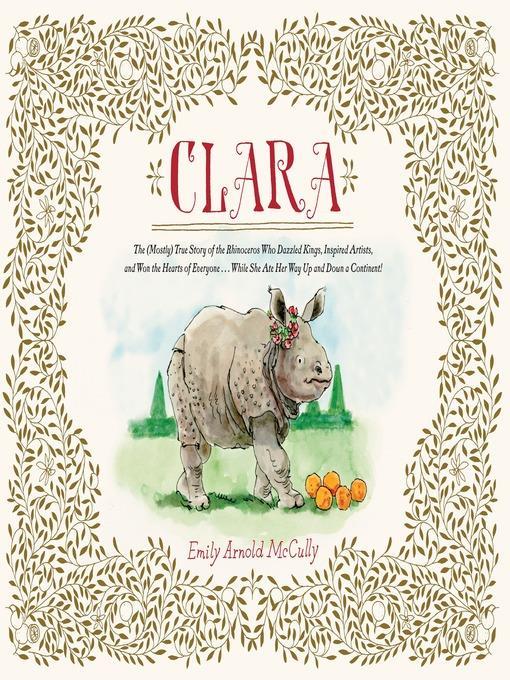
Clara
The (Mostly) True Story of the Rhinoceros Who Dazzled Kings, Inspired Artists, and Won the Hearts of Everyone . . . While She Ate Her Way Up and Down a Continent!
فرمت کتاب
ebook
تاریخ انتشار
2016
Lexile Score
730
Reading Level
3
ATOS
4.9
Interest Level
K-3(LG)
نویسنده
Emily Arnold McCullyشابک
9780553522488
کتاب های مرتبط
- اطلاعات
- نقد و بررسی
- دیدگاه کاربران
نقد و بررسی

Starred review from March 21, 2016
“Nearly three hundred years ago, when half the world was still a mystery to the other half,” a rhinoceros named Clara became the toast of Europe, thanks to her impresario, Captain Van der Meer. But this isn’t the story of a ruthless entrepreneur and his exploited zoological curiosity. With elegant watercolor and ink drawings and flawless storytelling, McCully (Queen of the Diamond) immerses readers in an era of powdered white wigs (“hairdressers created the style à la rhinocéros”) and tricorne hats while capturing a relationship that exemplifies absolute trust and unflagging devotion. Every day, Clara grows by 20 pounds and eats more than 100 pounds of food; moving her requires ever-bigger wagons, and, in one case, a custom-made raft. Yet this interspecies bond only deepens: Van der Meer dotes on his “Clarakin,” and on page after page, Clara regards him with openhearted affection—she is his eager collaborator to the very end. McCully calls this a “mostly” true story, and perhaps by strict historical standards, that’s correct. But its emotional veracity is never in question. Ages 4–8. Agent: Susan Cohen, Writers House.

March 15, 2016
An orphaned rhinoceros, acquired by a Dutch sea captain in India, captivates 18th-century Europe during her 17-year continental tour. Capt. Van der Meer orders Clara hoisted onto his ship for the voyage around the Cape of Good Hope. The rhino eats hay, drinks water, and "adore[s] oranges and beer." Fish oil is used to lubricate her hide. Once home in Holland, the captain plots logistics for Clara's "grand tour." McCully portrays a developing bond between Clara and her keeper, who "looked deep into his rhino's eyes and felt calm. Clara might have been homely on the outside, but she had a beautiful soul." The Prussian king, Frederick the Great, helps fund the tour, but Clara's 5,000-pound appetite proves financially challenging. Louis XV dismisses the captain from Versailles when Clara's not proffered as a gift for his menagerie. Paris is mad for Clara, though: she inspires composers, poets, sculptors, painters, scientists, and even hairdressers and dressmakers, as styles a la rhinoceros become the rage. McCully's delicately inked watercolors span double-page spreads for expansive scenes, including one for Clara's death. Smaller spots portray vignettes, as when Clara sprouts, then loses her horn. Oranges--so enticing to Clara--recur as a motif throughout. Endpapers map the sea and land journeys, and McCully's note provides historical context for what would be considered an inhumane display today. For all its problematic nature, a sweetly portrayed relationship. (author's note, resources) (Picture book. 5-8)
COPYRIGHT(2016) Kirkus Reviews, ALL RIGHTS RESERVED.

May 1, 2016
PreS-Gr 3-In 1741, a Dutch sea captain, Douwemont Van der Meer, transported Clara, a young rhinoceros, from India to his home in Leiden. For the next 17 years, Van der Meer transported her to dozens of cities throughout Europe, including Berlin, Rome, Paris, and Vienna. Clara charmed royals such as Empress Maria Theresa and Louis XV. She amazed peasants and aristocrats, who paid to see her. Poets, painters, and musicians created works in her honor. McCully carries readers on these travels while never losing sight of the relationship between the captain and Clara. Van der Meer needed to raise money constantly to satisfy Clara's prodigious appetite for bread and hay and her fondness for oranges and beer. She repaid him with affection and patience during the travels and exhibitions. McCully's watercolor illustrations capture the fashions and landscapes of the time. Panoramas such as the entourage sailing on a huge raft down the Rhine convey the spectacular undertaking involved in Clara's travels. An extensive author's note supplies additional information on Clara's story and the current state of rhinoceros populations. Consider pairing this title with Mary Tavener Holmes's My Travels with Clara, which incorporates photos of paintings, coins, and figurines with Clara's image.
Copyright 2016 School Library Journal, LLC Used with permission.

Starred review from May 1, 2016
Grades K-3 *Starred Review* In 1741, Captain Van der Meer sailed to India and returned to Holland with a mythical beast, an orphaned, one-year-old rhinoceros named Clara. Van der Meer grew to love his new friend, who rewarded his kindness with affection and trust. He took her throughout Europe, where crowds and even royal heads of state came to see her. As she grew, the problem of raising money to feed her became more challenging, but Van der Meer persisted, and they traveled together for 17 years, until Clara's death. In this smoothly written, fictionalized tale based on historical facts, McCully shows what a marvel it was at that time before nature films, photography, and zoos for people to see a large, unfamiliar animal, though in an appended note, she mentions that today we know that confining and exhibiting a wild animal is inhumane. Graceful, expressive, and beautifully composed, the ink-and-watercolor illustrations portray the young rhino as small, easygoing, and adorable, and the older Clara as large, gentle, and still adorable. Pair this handsome volume with the many history-based picture books, such as Dianne Hofmeyr's Zeraffa Giraffa (2014), telling of a giraffe that traveled from Egypt to France in 1826 and, like Clara, drew admiring crowds wherever she went.(Reprinted with permission of Booklist, copyright 2016, American Library Association.)

























دیدگاه کاربران